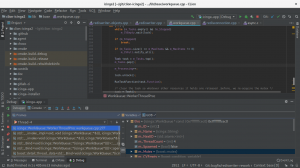I dislike IDEs, at least I tell myself and others that. A 200 line long .vimrc gives a lot more street cred than clicking on a colored icon and selecting some profile that mostly fits ones workflow. So does typing out breakpoints in GDB compared to just clicking left of a line. Despite those very good reasons I went ahead and gave Goland and CLion, two JetBrains products for Go and C/C++ respectively, a chance. The following details my experiences with a kind of software I never seen much use for, the problems I ran into, and how it changed my workflow.
Installation and Configuration

A picture of my IDE wouldn’t do much good, they all look the same. So here’s a baby seal.
Source: Ville Miettinen from Helsinki, Finland
First step is always the installation. With JetBrains products being mostly proprietary, there are no repositories for easy installation and updating. But for the first time I had something to put in
/opt. When going through the initial configuration wizard one plugin caught my eye: „IdeaVim“. Of course I decided to install and activate said plugin but quickly had to realize it does not work the same simply running vim in a window.This „Vim emulation plug-in for IDEs based on the IntelliJ platform“ sadly does for one not offer the full Vim experience and the key bindings often clash with those of the IDE. Further I started getting bothered by having to manage the Vim modes when wanting to write code.
I sometimes miss the ability to easily edit and move text the way Vim allows, the time I spend using the mouse to mark and copy text using the mouse are seconds of my life wasted I’ll never get back!
Except for the underlying compiler and language specific things both IDEs work the same, identical layout, window options, and most plugins are shared, so I won’t talk about the tool chain too much. But it needs to be said that Goland just works, possibly because building a Go project seems simpler than a C++ one. Getting CLion to work with CMake is tiresome, the only way to edit directives is by giving them to the command like you would on the shell. This would not bother me as much if CMake didn’t already have a great GUI.
Coding and Debugging
Yet I wouldn’t be still using those programs if there weren’t upsides. The biggest being the overview over the whole project, easily finding function declarations and splitting windows as needed. These are things Vim can be made to do, but it does not work as seamless as it does in the IntelliJ world. It made me realize how little time is spent the actual typing of code, most of it is reading code, drawing things and staring at a prototype until your eyes bleed confusion (sometimes code is not well commented). The debuggers, again specifically the one of Goland, work great! Sometimes I have to talk to GDB directly since there are many functions but too few buttons, but the typical case of setting a breakpoint and stepping through to find some misplaced condition is simple and easy.
There are a few features I have not found a use for yet e.g. code generators and I still manage my git repositories from the shell. The automatic formatting is cool, again especially in Go where there is one standard and one tool for it. Other than that I run into a few bugs now and then, one that proved to be quite a hassle is the search/search and replace sometimes killing my entire window manager. Were it free software, there’d be a bug report. But for now I work around it. Maybe I’ll drop CLion but I doubt I’ll be writing any Go code in Vim anytime soon.
If you think you have found the perfect IDE or just want to share Vim tips, meet me at the OSMC in November!


















